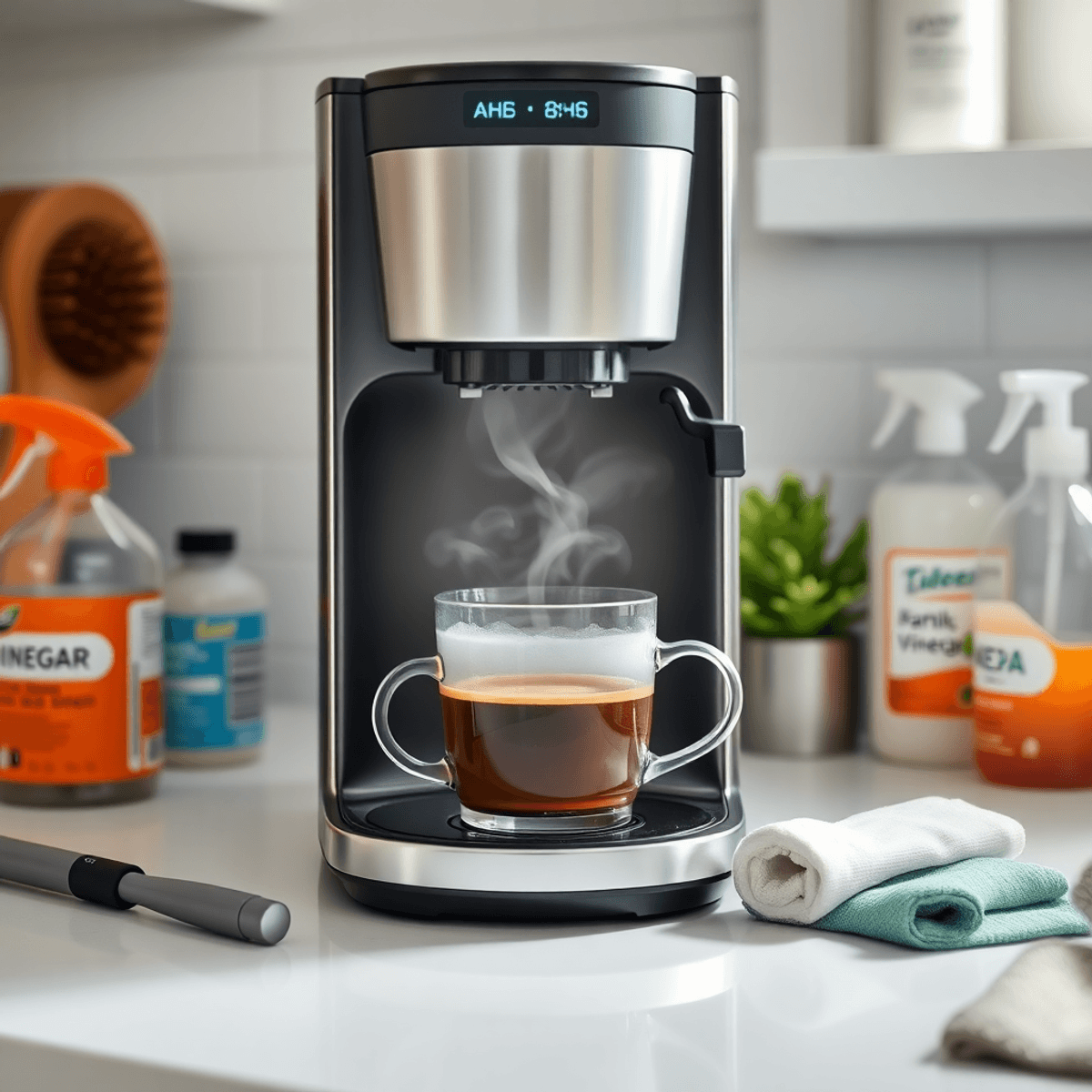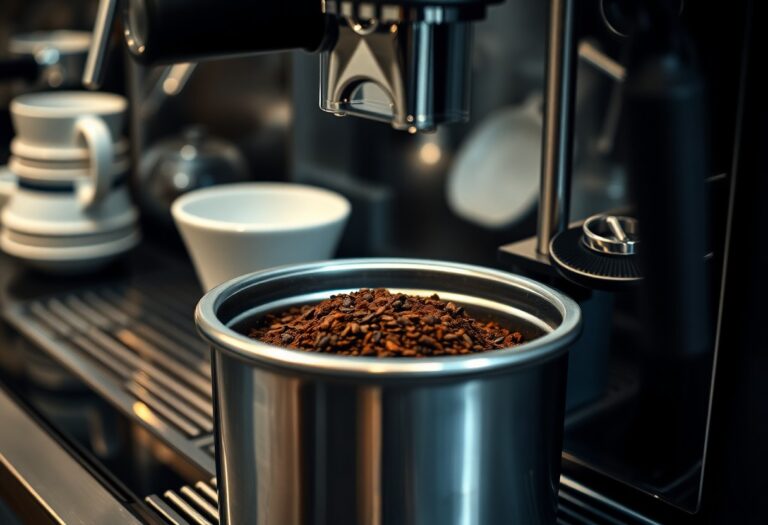How to Clean Out a Coffee Machine: Deep Cleaning Methods
Keeping your coffee machine clean is essential for both flavor and health. A neglected coffee maker can harbor oils, mineral deposits, and bacteria that spoil your brew’s taste and pose health risks. Regular deep cleaning coffee maker routines ensure you enjoy fresh, delicious coffee every time.
This guide on How to Clean Out a Coffee Machine: Deep Cleaning Methods offers clear, step-by-step instructions to help you maintain your machine’s performance. Whether you use a drip coffee machine or an espresso maker, these practical tips will keep your equipment in top shape and improve your daily coffee experience.
For those who own a Keurig, it’s important to follow specific maintenance instructions to ensure optimal performance. If you’re unsure about how to use a Keurig coffee machine, our comprehensive guide has got you covered.
When it comes to cleaning a Keurig coffee machine, our ultimate maintenance guide provides all the necessary steps. And if you’re in the market for a new model, check out our reviews on the best Keurig coffee machines.
Understanding the Need for Deep Cleaning Your Coffee Machine
Over time, coffee machines can accumulate common contaminants such as oily sludge, mineral deposits, yeast, mold, and bacteria. These buildups can significantly impact the flavor of your brew and even pose potential health risks if not properly addressed. Here’s what neglecting to deep clean your coffee machine can lead to:
- Oily Sludge: Accumulation of oils from coffee beans can turn rancid over time, imparting a bitter taste to your brew.
- Mineral Deposits: Hard water can leave behind mineral deposits that affect the heating elements and water flow, leading to inconsistent brewing temperatures.
- Yeast and Mold: Moist environments within the machine provide an ideal breeding ground for yeast and mold, which can introduce off-flavors and odors into your coffee.
- Bacteria: Residues from previous brews can harbor bacteria, potentially causing health issues if consumed regularly.
Importance of Regular Deep Cleaning
Regular deep cleaning is essential to remove these contaminants and ensure that your coffee machine functions optimally while preserving the quality and taste of your favorite brews. For instance, following a comprehensive cleaning guide for specific models like the Krups or Ninja can help maintain their performance.
Other Aspects of Coffee Machine Maintenance
However, deep cleaning is just one aspect of coffee machine maintenance. Understanding how to use these machines effectively is equally important. If you’re a beginner, you might find our beginners guide on making coffee with a coffee machine useful.
For those who enjoy espresso, we have resources on how to make espresso without an espresso machine or how to make coffee with an espresso machine.
Recognizing Signs That It’s Time for a Deep Clean
Knowing the signs to clean your coffee machine can save you from brewing issues and costly repairs. Pay attention to these common coffee machine maintenance indicators:
- Unusual brewing noises: Grinding, gurgling, or sputtering sounds often mean mineral buildup or clogged internal parts. This can slow down water flow and affect extraction quality.
- Slower brewing times: If your machine takes longer than usual to brew a cup, internal blockages might be restricting water circulation.
- Colder than usual coffee temperatures: A drop in temperature can suggest heating elements are coated with scale, reducing their efficiency.
- Unpleasant odors: Musty or sour smells coming from the machine indicate yeast or mold growth inside damp areas.
- Visible residue or buildup: Check parts such as the carafe, filter basket, and water reservoir for oily sludge or white mineral deposits.
- Bitter or off taste in brewed coffee: Changes in flavor often point to accumulated contaminants interfering with the brewing process.
Ignoring these signs can lead to persistent problems that degrade both flavor and machine performance. Regular inspection for these indicators allows you to act before issues worsen. For instance, if you notice unusual brewing noises or slower brewing times, it might be time for a deep clean. You can follow these essential maintenance tips to get your coffee machine back in shape.
If you’re using a French press and encounter similar issues, this guide on how to use a French press coffee machine could prove useful. Alternatively, if you find yourself without a coffee machine, don’t fret. There are manual brewing methods that can still deliver a great cup of coffee.
For specific machines like the Mr. Coffee, this maintenance guide will provide tailored cleaning advice. Lastly, if you’re considering using vinegar as a cleaning agent but unsure about the quantities, this article on how much vinegar to clean a coffee machine will give you the proper ratios to use.
Gathering Your Cleaning Supplies: What You Need to Get Started
When it comes to deep cleaning your coffee machine, having the right supplies is essential to ensure a thorough and effective cleaning process. Here are the key materials you will need to gather before you begin:
- White Distilled Vinegar: This common household item is a versatile cleaning agent that can help dissolve mineral deposits and sanitize your coffee maker. It is especially effective for descaling and removing buildup in the internal components of the machine.
- Baking Soda: An alternative to vinegar, baking soda can also be used for cleaning your coffee machine. It helps eliminate odors, remove stains, and acts as a gentle abrasive for scrubbing away residue.
- Commercial Descaling Products: For stubborn mineral scale or tough buildup that cannot be easily removed with vinegar or baking soda, there are various commercial descaling products available in the market. These products are specifically formulated to break down mineral deposits and restore the performance of your coffee machine.
Having these supplies on hand will ensure that you can efficiently tackle any buildup or residue in your coffee maker, helping to maintain its longevity and the quality of your brewed coffee. Remember to follow the manufacturer’s instructions and safety guidelines when using cleaning agents to avoid damaging your machine.
Step-by-Step Guide to Deep Cleaning Different Types of Coffee Machines
Drip Coffee Machines
When deep cleaning a drip coffee machine, the vinegar method is highly effective. Follow these detailed steps for a thorough clean:
- Prepare the Solution: Mix equal parts white distilled vinegar and water in the machine’s reservoir.
- Begin the Cleaning Process: Start a brew cycle, allowing half of the solution to run through.
- Soak and Clean: Turn off the machine once half the solution has brewed and let it sit for 30-60 minutes to dissolve buildup.
- Complete the Cycle: Resume the brew cycle to finish running the vinegar solution through.
- Flush with Water: Run fresh water cycles through the machine to rinse out any remaining vinegar residue.
For a more detailed understanding of this natural cleaning method, you can refer to our comprehensive guide.
Espresso Machines
Deep cleaning espresso machines requires attention to specific areas like group heads and steam wands to prevent milk residue buildup. Here are some key steps:
- Backflushing Group Heads: Use a blind portafilter or backflush disc with espresso machine cleaner to clean group heads thoroughly. For expert tips on this process, check out our detailed guide on how to clean your espresso machine group head.
- Cleaning Steam Wands: Soak steam wands in warm, soapy water after each use and wipe them down to prevent milk buildup.
- Descale Regularly: Use a descaling solution suitable for espresso machines to remove mineral deposits in the boiler.
If you’re interested in learning how to descale a specific type of coffee machine, such as a Keurig, we have a complete step-by-step guide on how to descale a Keurig coffee machine.
By following these step-by-step instructions tailored to each type of coffee machine, you can ensure a deep clean that enhances both taste and performance. For instance, if you own a Ninja coffee machine, our article on how to use a Ninja coffee machine could be beneficial. Similarly, for Cuisinart coffee machines, we have step-by-step instructions available in our guide on how to clean a Cuisinart coffee machine. Lastly, if you’re looking for information on how to descale any coffee machine, our comprehensive decalcification guide would be an excellent resource.
Maintaining Your Coffee Machine Between Deep Cleans: Tips for Longevity
Regular maintenance is key to prolonging the lifespan of your coffee machine. By incorporating these simple tips into your routine, you can ensure that your machine continues to brew delicious coffee while operating at its best capacity.
- Daily rinsing of removable parts after use can help prevent residue buildup.
- Using filtered water in your machine can reduce mineral deposits formation.
Recommended Frequency of Deep Cleaning Based on Usage Patterns
Knowing how often to clean your coffee maker is essential for keeping it in peak condition. Your maintenance schedule for coffee machines should adjust based on usage intensity and water quality.
1. Daily Users
If you brew coffee every day, a monthly deep cleaning routine is necessary. This frequency keeps mineral deposits, oily residues, and bacterial growth under control. It ensures your machine delivers fresh, flavorful coffee consistently and avoids performance issues caused by buildup. Following these brewing instructions for a filter coffee machine can help optimize daily usage.
2. Occasional Users
For those who use their coffee machine less frequently—several times a week or only on weekends—cleaning every 3 to 6 months is usually sufficient. The exact timing depends on how often you operate the machine and the hardness of your water supply. Hard water accelerates mineral scaling, requiring more frequent descaling. If you’re using a Mr. Coffee machine, it’s important to understand its specific cleaning needs.
3. Hard Water Areas
If you live in an area with hard water, consider increasing cleaning frequency regardless of usage pattern. Mineral deposits form faster and can clog internal parts, affecting brewing efficiency and taste.
Establishing this routine as part of How to Clean Out a Coffee Machine: Deep Cleaning Methods helps prevent costly repairs and maintains the quality of your brew. Adjust the schedule according to your specific circumstances, but err on the side of more frequent cleaning if uncertain.
Conclusion
Consistently applying the deep cleaning methods outlined in How to Clean Out a Coffee Machine: Deep Cleaning Methods brings clear benefits. You will:
- Extend the lifespan of your coffee machine by preventing damaging buildup.
- Keep coffee fresh and flavorful, avoiding bitter or off tastes caused by residue.
- Reduce health risks linked to mold, bacteria, and yeast accumulation.
Deep cleaning is not just about maintenance; it’s about enhancing your daily coffee experience. Following these step-by-step methods ensures your machine performs at its best, brewing rich, satisfying coffee every time. Embrace the benefits of deep cleaning coffee machines to savor every cup with confidence.







